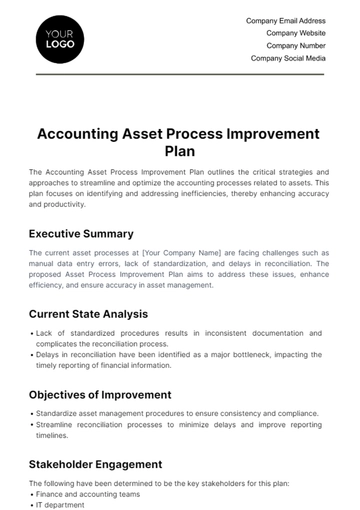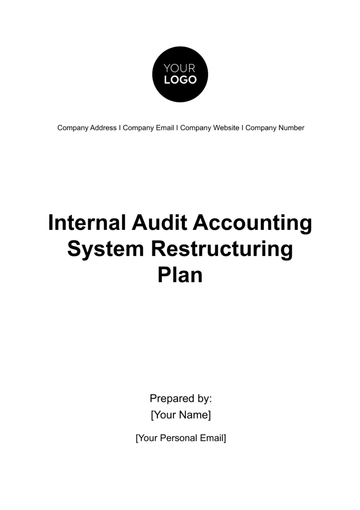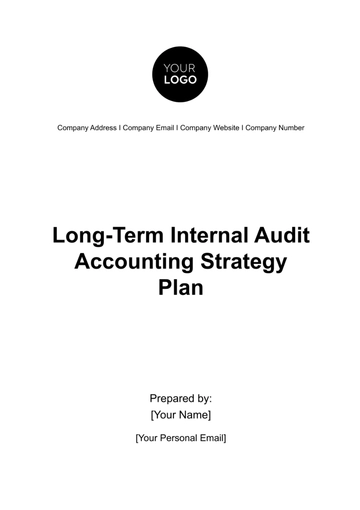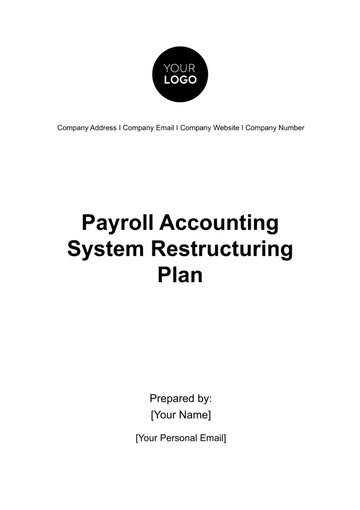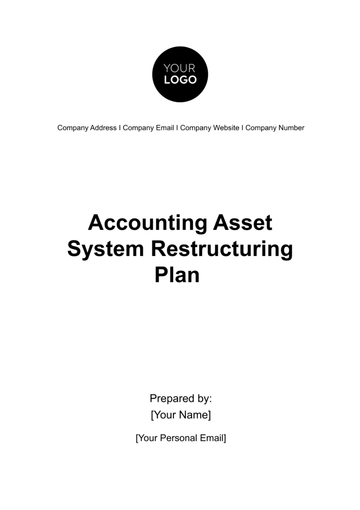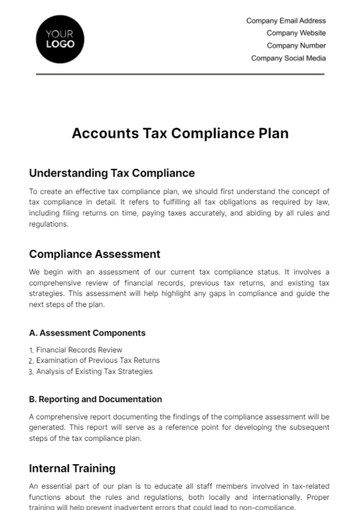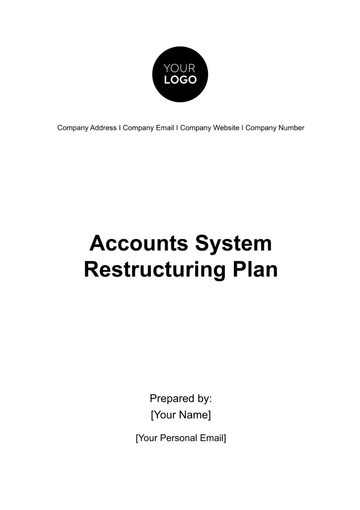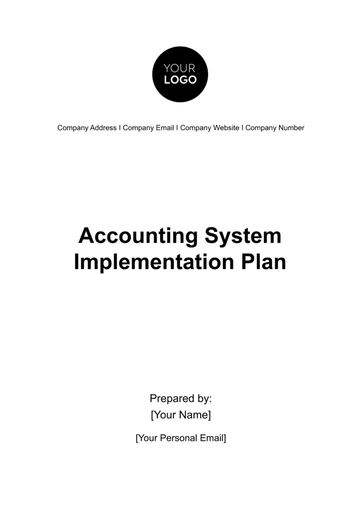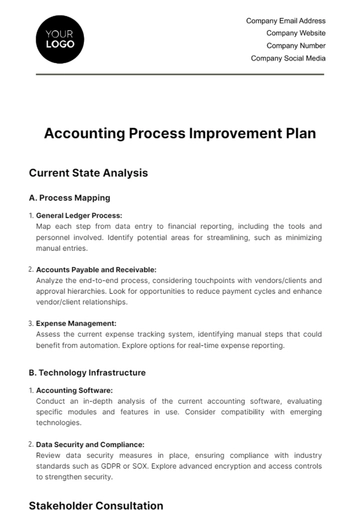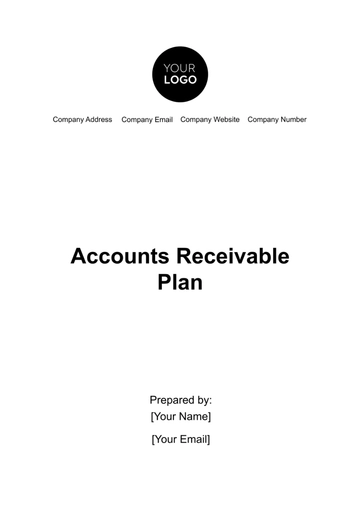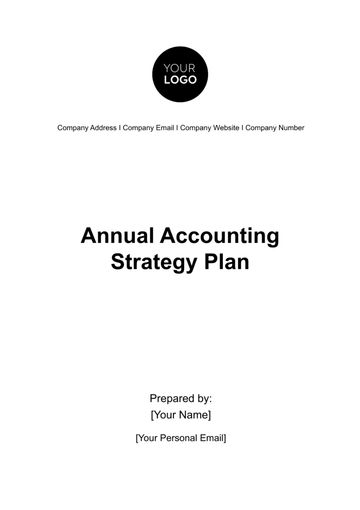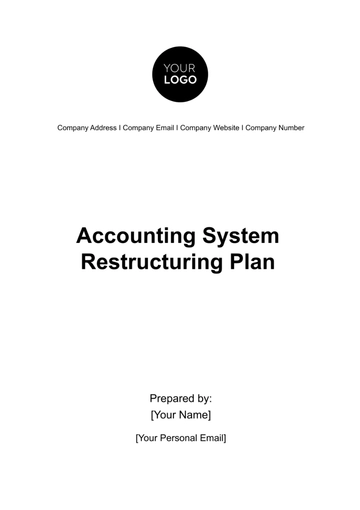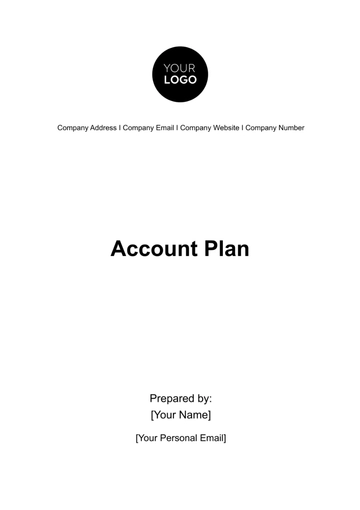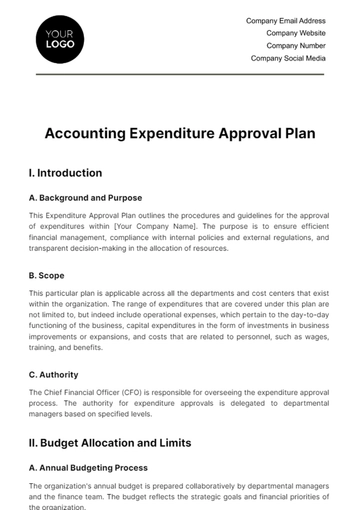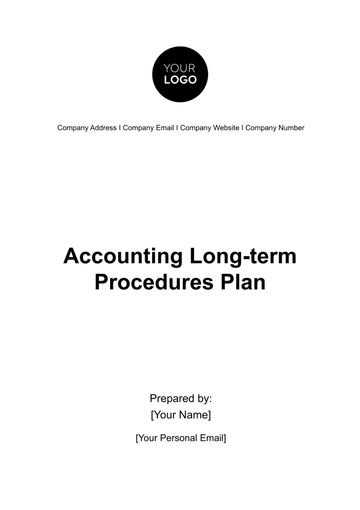Free Accounts Receivable Plan
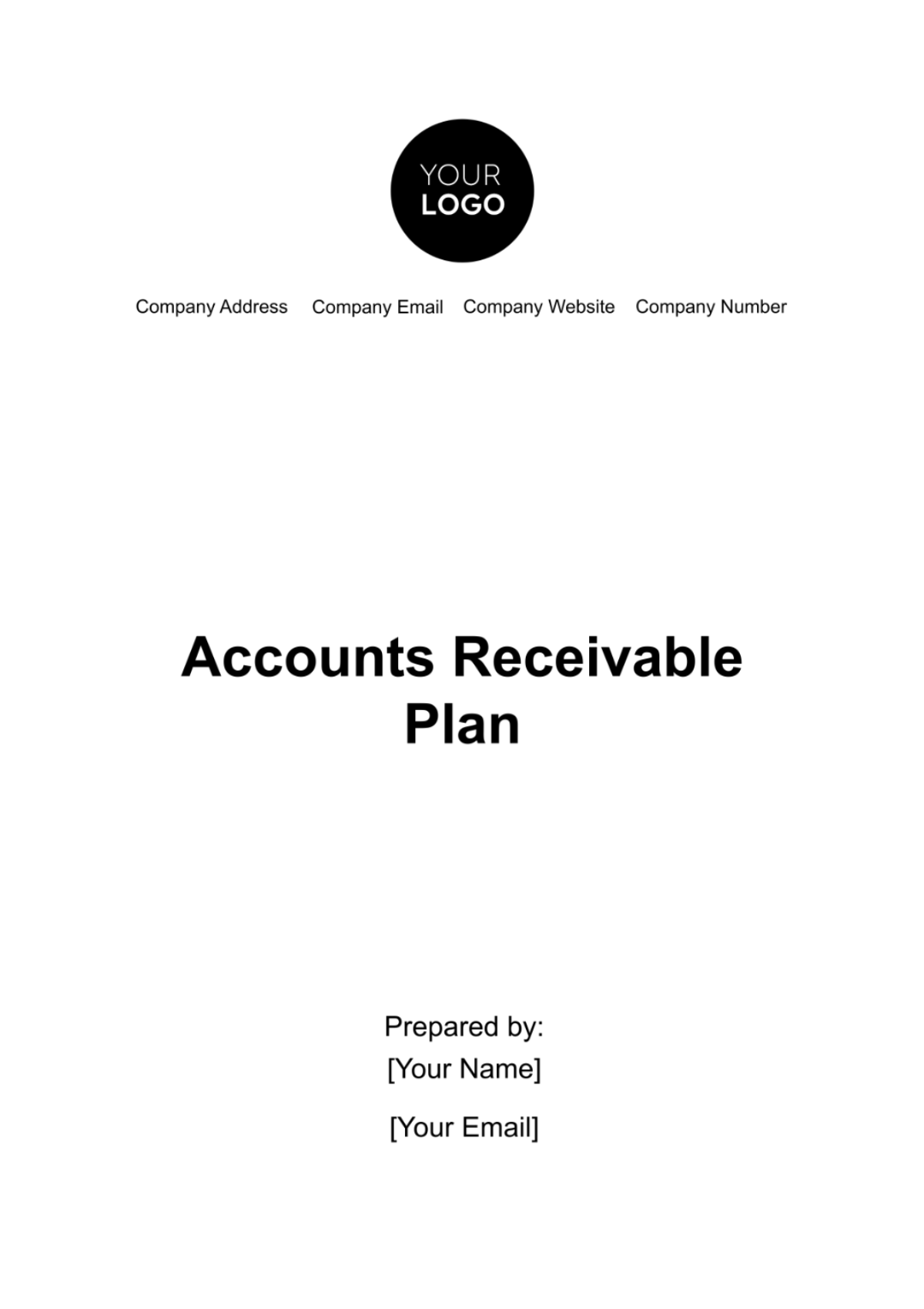
I. Introduction
A. Purpose
The purpose is threefold
Optimizing Cash Flow
Aiming to enhance cash flow by ensuring timely collections, reducing outstanding balances, and streamlining payment processes.
Improving Financial Stability
Contributing to overall financial stability by establishing effective invoicing procedures and credit terms, mitigating risks associated with delayed payments.
Enhancing Customer Relationships
Seeking to strengthen customer relationships through transparent communication and efficient collection strategies, fostering trust and loyalty.
B. Significance
This plan highlights its critical impact on various aspects of financial management:
Liquidity Management
Playing a pivotal role in maintaining optimal liquidity levels, ensuring the organization can meet its short-term obligations.
Strategic Decision-Making
Providing accurate financial data, empowering management to make informed strategic decisions.
Competitive Advantage
Serving as a source of competitive advantage by positioning the company as reliable and financially sound.
C. Scope
The scope is defined by three key parameters:
Business Units
Applicable across all business units, ensuring consistency and coherence in accounts receivable processes throughout the organization.
Customer Segments
Extending to all customer segments, irrespective of size or type, emphasizing inclusivity in implementing credit terms and collection strategies.
Time Frame
Designed for both short-term gains and long-term sustainability, providing flexibility to address immediate financial needs while aligning with broader strategic objectives.
II. Invoicing Procedures
Efficient invoicing is paramount to the success of the plan, ensuring a streamlined process for generating and dispatching invoices promptly. The table below outlines key elements, providing a structured overview of the essential components:
Item | Description |
|---|---|
Invoice Generation | Automated system that generates unique invoice numbers, incorporates due dates, and itemizes products or services provided. |
The automated system for generating unique invoice numbers is pivotal for tracking and organizing financial transactions. This system assigns distinct identifiers to each invoice, facilitating accurate record-keeping and simplifying the reconciliation process. Incorporating due dates ensures that customers are aware of payment timelines, reducing the likelihood of late payments. Furthermore, itemizing products or services provides transparency, allowing both the business and the customer to understand the nature and cost of the transaction.
Incorporating effective Invoicing Procedures is essential for the overall financial health of the business. Beyond the meticulous handling of individual components, such as automated invoice generation and comprehensive information inclusion, the significance lies in the systematic and organized nature of the process. Efficient invoicing ensures that the business operates smoothly by facilitating accurate financial record-keeping and reducing the likelihood of payment delays. Moreover, it establishes a transparent and trustworthy relationship with customers, contributing to positive customer experiences and long-term loyalty. Overall, a well-executed Invoicing Procedures section is pivotal for maintaining financial stability and fostering a robust foundation for funds management.
III. Credit Terms and Policies
A. Establishing Credit Terms
Definition of Credit Terms
We will explicitly define the credit terms offered to customers, including an annual interest rate of 5% for overdue payments and a 2% discount for early payments made within the first 15 days from the invoice date.
Customer Evaluation Criteria
Rigorous criteria for evaluating the creditworthiness of customers will be established. Factors such as a minimum credit score of 700, sustained financial stability, and a consistent track record of timely payments with our company will be considered.
Tiered Credit Limits
Implementing a scalable approach, tiered credit limits will be assigned based on assessed creditworthiness. Tier 1 customers will have a higher credit limit, ensuring alignment with their strong financial standing.
B. Defining Credit Policies
Terms of Sale
Specific terms of sale for products or services offered on credit will be outlined. This includes a 2% late payment fee applicable after the stipulated 30-day payment period.
Credit Approval Process
A systematic process for approving credit applications will be defined. This process encompasses stringent documentation requirements, internal approvals from the credit committee, and timely communication through a designated channel within 5 business days.
C. Mitigating Credit Risks
Credit Insurance Considerations
Exploration of credit insurance options will be conducted to mitigate potential losses due to customer defaults or insolvencies, considering a policy that covers 80% of the outstanding amount.
Collection of Collateral
Conditions for collecting collateral in case of default will be determined, with notifications sent through both email and registered mail. A 15-day grace period for resolution will be provided.
Credit Risk Reporting
A robust credit risk reporting system will be implemented, generating monthly reports to analyze and assess the overall credit risk exposure of the business. A detailed review will be presented to the finance team.
D. Customer Communication Strategy
Transparency in Communication
Emphasis on transparent communication with customers regarding credit terms will be a priority, ensuring clarity on expectations and consequences of non-compliance through monthly statements sent via both email and an online portal.
Effective Dispute Resolution
Protocols for addressing disputes related to credit terms promptly will be established, ensuring that customers can submit disputes through a dedicated online platform and receive a resolution within 10 business days.
Educational Outreach
Conducting educational outreach to customers will be part of our strategy, providing information on credit terms, policies, and the benefits of adherence to established guidelines through quarterly webinars and a dedicated FAQ section on our website.
IV. Customer Communication
A. Communication Channels
Diverse Communication Channels
We will utilize a variety of communication channels to reach our customers, including email, phone calls, and a secure online portal for document exchange.
Preference Assessment
An initial assessment will be conducted to understand customer communication preferences, allowing us to tailor our interactions to align with their preferred channels.
Opt-In Mechanism
Customers will be provided with an opt-in mechanism, ensuring that they have control over the communication channels through which they receive information.
B. Billing and Invoice Notifications
Timely Billing Notifications
Billing notifications will be sent in a timely manner, with a clear breakdown of charges and payment details provided through the selected communication channels.
Advance Invoice Notices
Customers will receive advance notices for upcoming invoices, allowing them to anticipate and plan for upcoming payments.
Customizable Invoice Preferences
An option for customers to customize their invoice preferences will be available, allowing them to choose the format and frequency of invoice notifications.
C. Payment Reminders
Automated Reminder System
An automated reminder system will be in place, sending reminders to customers as their payment due dates approach, utilizing multiple channels for effective communication.
Personalized Reminder Messages
Reminders will be personalized, taking into account individual customer payment histories and preferences.
Interactive Reminder Response
An interactive response mechanism will be integrated, allowing customers to confirm payment or communicate any potential issues directly through the reminder notifications.
D. Handling Customer Inquiries
Dedicated Customer Support
A dedicated customer support team will be available to address customer inquiries promptly and efficiently.
Multi-Channel Inquiry Handling
Inquiries can be submitted through various channels, including email, phone calls, and a designated online inquiry platform.
24/7 Accessibility
A 24/7 online portal will be accessible for customers to submit inquiries and receive automated responses, providing immediate assistance for common queries.
V. Collection Strategies
Effectively managing collections is a key aspect of the plan, ensuring a proactive approach to handle late payments and mitigate financial risks. The table below provides a structured overview of our strategies:
Item | Description |
|---|---|
Reminder Communication | Automated reminders sent to customers nearing payment deadlines, utilizing multiple channels such as emails, messages, and personalized notifications. |
Automated reminder communication plays a crucial role in maintaining a proactive collections strategy. By leveraging various channels such as emails, messages, and personalized notifications, businesses can consistently remind customers of approaching payment deadlines. This not only serves as a gentle nudge but also establishes a transparent and communicative relationship. Automated reminders reduce the likelihood of oversights, providing customers with ample notice and allowing them to manage their payment responsibilities effectively.
Collection Strategies hold immense importance for the financial health and stability of the business. Timely and effective collections directly impact cash flow, ensuring a steady stream of revenue. The proactive nature of these strategies helps in preventing prolonged outstanding balances, reducing the risk of bad debt write-offs. Additionally, a well-implemented collections process reinforces the credibility of the business, instilling confidence in customers and stakeholders. It aligns with the overall objective of optimizing funds management, contributing to the sustainability and competitiveness of the organization. Efficient collections not only secure revenue but also cultivate positive relationships with customers, laying the groundwork for long-term financial success.
VI. Cash Application Process
A. Receiving and Recording Payments
Diverse Payment Channels
We will accommodate diverse payment channels, including online transfers, credit cards, and checks, ensuring flexibility for our customers.
Automated Payment Confirmation
An automated system will confirm the receipt of payments promptly, providing customers with instant acknowledgment and transparency in the payment process.
Real-time Payment Recording
Payments will be recorded in real-time within our system, minimizing delays and ensuring accurate and up-to-date financial records.
B. Payment Reconciliation
Systematic Reconciliation Process
We will implement a systematic reconciliation process, cross-referencing received payments with outstanding invoices to identify any discrepancies.
Automated Reconciliation Tools
Utilizing automated reconciliation tools, discrepancies will be flagged for review, reducing manual effort and enhancing accuracy.
Regular Reconciliation Audits
Regular audits of the reconciliation process will be conducted to identify and address any systemic issues, ensuring continuous improvement.
C. Unapplied and Misapplied Payments
Identification Mechanism
We will establish a mechanism to promptly identify unapplied and misapplied payments, preventing financial inaccuracies and ensuring proper allocation.
Clear Communication with Customers
In cases of unapplied or misapplied payments, clear communication channels will be initiated with customers to rectify the issue promptly.
Resolution Timeframe
Unapplied or misapplied payments will be resolved within a defined timeframe of 5 business days, minimizing disruptions and ensuring a seamless cash application process.
VII. Technology and Tools
The integration of technology and tools is pivotal to the success of the plan, enhancing the efficiency and automation of accounts receivable processes. The table below outlines a structured overview of the essential components:
Item | Description |
|---|---|
Accounting Software | Implementation of advanced accounting software for automated invoice generation, real-time tracking, and financial reporting. |
The implementation of advanced accounting software is a cornerstone in leveraging technology for efficient accounts receivable management. This tool facilitates automated invoice generation, ensuring the creation of accurate and consistent invoices with unique identifiers. Additionally, it enables real-time tracking of financial transactions, providing instant visibility into the status of outstanding balances. The integration of financial reporting features further enhances the analysis of accounts receivable data, empowering businesses to make informed strategic decisions based on up-to-date information.
Embracing advanced technological solutions transcends mere operational enhancements; it signifies a strategic commitment to agility, adaptability, and sustained competitiveness. The infusion of cutting-edge tools transforms accounts receivable processes into dynamic and responsive components of the business ecosystem. By leveraging technology, organizations not only streamline routine tasks but also position themselves to navigate the complexities of modern financial landscapes. The emphasis on automation, real-time tracking, and data analytics symbolizes a forward-looking approach, ensuring that the business is equipped to meet the challenges of an ever-evolving marketplace. These technologies and tools as a whole, underscores the critical role of innovation in fortifying the foundation of accounts receivable management and, consequently, the overall financial health of the organization.
VIII. Budget Integration
The integration of budget considerations within the plan is paramount for aligning financial goals and ensuring prudent fiscal management. The graph below outlines our budget to streamline the plan:
The allocated budget of $50,000 for Accounting Software signifies a strategic investment in advanced tools for efficient accounts receivable management. This includes the implementation of sophisticated software to automate invoice generation, real-time tracking, and financial reporting. The budget ensures the integration of a robust system that not only streamlines operations but also enhances accuracy and transparency in financial processes.
Budget Integration holds profound significance as it aligns financial resources with strategic objectives, providing a comprehensive roadmap for efficient accounts receivable management. By delineating specific allocations for crucial components such as accounting software we can ensure a judicious use of funds, promoting operational excellence. The budget integration process not only fosters transparency in financial planning but also enables proactive decision-making by identifying potential areas for improvement through variance analysis and forecasting. Moreover, it emphasizes financial accountability, ensuring that resources are directed toward areas critical for optimizing cash flow, enhancing customer relationships, and embracing technological advancements.
IX. Reporting and Analysis
A. Report Generation and Distribution
Automated Report Generation
Implement automated systems for generating a variety of reports, covering key metrics, performance indicators, and financial insights.
Customizable Report Templates
Provide customizable report templates to cater to the specific information needs of different stakeholders, ensuring relevance and clarity.
Scheduled Distribution
Schedule regular distribution of reports to relevant stakeholders through secure and accessible channels, promoting timely decision-making.
B. Key Performance Indicators (KPIs)
Identification of KPIs
Identify and define key performance indicators relevant to accounts receivable, such as DSO (Days Sales Outstanding), aging reports, and collection efficiency.
Real-time KPI Monitoring
Implement systems for real-time monitoring of KPIs, enabling swift response to emerging trends and issues.
Benchmarking against Industry Standards
Regularly benchmark our KPIs against industry standards to assess performance relative to peers and identify areas for improvement.
C. Trend Analysis
Historical Data Examination
Conduct in-depth analysis of historical data to identify patterns, trends, and anomalies in accounts receivable performance.
Predictive Trend Modeling
Utilize predictive modeling techniques to anticipate future trends and proactively address potential challenges.
Continuous Trend Monitoring
Establish a continuous monitoring mechanism for tracking evolving trends, ensuring adaptability to changing financial landscapes.
D. Variance Analysis
Budget vs. Actual Analysis
Conduct thorough variance analysis between budgeted and actual accounts receivable performance, identifying areas of overperformance or underperformance.
Root Cause Identification
Systematically identify the root causes of variances, facilitating targeted interventions for improvement.
Continuous Improvement Feedback Loop
Establish a feedback loop for incorporating insights from variance analysis into continuous improvement initiatives within the plan.
E. Compliance and Risk Reporting
Regulatory Compliance Tracking
Implement systems to track and report regulatory compliance within accounts receivable processes.
Risk Assessment Reports
Regularly generate risk assessment reports, highlighting potential risks and proposing risk mitigation strategies.
Internal Control Audits
Conduct periodic internal control audits to ensure adherence to established policies and identify opportunities for strengthening controls.
F. Stakeholder Collaboration
Cross-functional Collaboration
Foster collaboration between finance, sales, and customer support teams to enhance the holistic understanding of accounts receivable dynamics.
Interactive Reporting Sessions
Facilitate interactive reporting sessions to gather insights from different departments and align strategies for improved accounts receivable performance.
Feedback Integration
Actively integrate feedback from stakeholders into the reporting and analysis process, ensuring that the information generated is relevant and actionable.
X. Legal and Compliance Considerations
A. Regulatory Compliance Framework
Comprehensive Regulatory Review
Conduct a thorough review of relevant regulations governing accounts receivable processes semi-annually, ensuring a comprehensive understanding of legal requirements.
Documented Compliance Procedures
Establish clear and documented procedures outlining how the plan aligns with applicable regulatory requirements. Internal audits will be conducted annually to assess ongoing compliance, identify areas of improvement, and promptly address any deviations from regulatory standards.
B. Contractual Agreements
Contractual Clarity
Ensure clarity in contractual agreements related to accounts receivable, clearly outlining payment terms, interest rates, and any legal implications for non-compliance. Contractual agreements will undergo periodic reviews every two years to ensure alignment with current legal standards and business requirements.
Periodic Contract Reviews
Periodically review contractual agreements to ensure they remain aligned with current legal standards and business requirements. Engage legal counsel in the review and drafting of contractual agreements, ensuring legal precision and minimizing potential disputes.
C. Data Protection and Privacy
Data Privacy Compliance
Implement measures to ensure compliance with data protection and privacy regulations, safeguarding sensitive customer information. Conduct quarterly reviews of data security protocols, including encryption and access controls, to protect against unauthorized access and potential breaches.
Data Security Protocols
Establish robust data security protocols, including encryption and access controls, to protect against unauthorized access and potential breaches. Implement clear mechanisms for obtaining and managing customer consent for the collection and use of their personal information, and conduct an annual review of these mechanisms.
D. Dispute Resolution Mechanisms
Defined Dispute Resolution Process
Clearly define a structured process for resolving disputes related to accounts receivable, ensuring transparency and fairness. Monitor and report on the average resolution time for disputes on a monthly basis.
Mediation and Arbitration Considerations
Assess the feasibility of incorporating mediation or arbitration clauses in contracts to expedite dispute resolution processes. Maintain thorough documentation of all communication and transactions related to disputes, supporting legal compliance and resolution, and conduct quarterly audits of this documentation.
E. Anti-Fraud Measures
Risk Assessment for Fraud
Conduct regular risk assessments to identify potential vulnerabilities to fraud within accounts receivable processes. Implement controls, such as segregation of duties and transaction monitoring, to prevent, detect, and respond to fraudulent activities, and report on fraud prevention KPIs quarterly.
Implementation of Anti-Fraud Controls
Implement controls, such as segregation of duties and transaction monitoring, to prevent, detect, and respond to fraudulent activities. Provide comprehensive training to employees on anti-fraud policies and procedures semi-annually, fostering awareness and vigilance.
- 100% Customizable, free editor
- Access 1 Million+ Templates, photo’s & graphics
- Download or share as a template
- Click and replace photos, graphics, text, backgrounds
- Resize, crop, AI write & more
- Access advanced editor
Plan and manage receivables effectively with our customizable Accounts Receivable Plan Template, accessible on Template.net! This editable solution is now even better with our advanced AI Editor Tool. Tailor your receivables plan effortlessly to your business objectives, ensuring proactive management and timely collections. Optimize accounts receivable strategy with clarity now!
You may also like
- Finance Plan
- Construction Plan
- Sales Plan
- Development Plan
- Career Plan
- Budget Plan
- HR Plan
- Education Plan
- Transition Plan
- Work Plan
- Training Plan
- Communication Plan
- Operation Plan
- Health And Safety Plan
- Strategy Plan
- Professional Development Plan
- Advertising Plan
- Risk Management Plan
- Restaurant Plan
- School Plan
- Nursing Home Patient Care Plan
- Nursing Care Plan
- Plan Event
- Startup Plan
- Social Media Plan
- Staffing Plan
- Annual Plan
- Content Plan
- Payment Plan
- Implementation Plan
- Hotel Plan
- Workout Plan
- Accounting Plan
- Campaign Plan
- Essay Plan
- 30 60 90 Day Plan
- Research Plan
- Recruitment Plan
- 90 Day Plan
- Quarterly Plan
- Emergency Plan
- 5 Year Plan
- Gym Plan
- Personal Plan
- IT and Software Plan
- Treatment Plan
- Real Estate Plan
- Law Firm Plan
- Healthcare Plan
- Improvement Plan
- Media Plan
- 5 Year Business Plan
- Learning Plan
- Marketing Campaign Plan
- Travel Agency Plan
- Cleaning Services Plan
- Interior Design Plan
- Performance Plan
- PR Plan
- Birth Plan
- Life Plan
- SEO Plan
- Disaster Recovery Plan
- Continuity Plan
- Launch Plan
- Legal Plan
- Behavior Plan
- Performance Improvement Plan
- Salon Plan
- Security Plan
- Security Management Plan
- Employee Development Plan
- Quality Plan
- Service Improvement Plan
- Growth Plan
- Incident Response Plan
- Basketball Plan
- Emergency Action Plan
- Product Launch Plan
- Spa Plan
- Employee Training Plan
- Data Analysis Plan
- Employee Action Plan
- Territory Plan
- Audit Plan
- Classroom Plan
- Activity Plan
- Parenting Plan
- Care Plan
- Project Execution Plan
- Exercise Plan
- Internship Plan
- Software Development Plan
- Continuous Improvement Plan
- Leave Plan
- 90 Day Sales Plan
- Advertising Agency Plan
- Employee Transition Plan
- Smart Action Plan
- Workplace Safety Plan
- Behavior Change Plan
- Contingency Plan
- Continuity of Operations Plan
- Health Plan
- Quality Control Plan
- Self Plan
- Sports Development Plan
- Change Management Plan
- Ecommerce Plan
- Personal Financial Plan
- Process Improvement Plan
- 30-60-90 Day Sales Plan
- Crisis Management Plan
- Engagement Plan
- Execution Plan
- Pandemic Plan
- Quality Assurance Plan
- Service Continuity Plan
- Agile Project Plan
- Fundraising Plan
- Job Transition Plan
- Asset Maintenance Plan
- Maintenance Plan
- Software Test Plan
- Staff Training and Development Plan
- 3 Year Plan
- Brand Activation Plan
- Release Plan
- Resource Plan
- Risk Mitigation Plan
- Teacher Plan
- 30 60 90 Day Plan for New Manager
- Food Safety Plan
- Food Truck Plan
- Hiring Plan
- Quality Management Plan
- Wellness Plan
- Behavior Intervention Plan
- Bonus Plan
- Investment Plan
- Maternity Leave Plan
- Pandemic Response Plan
- Succession Planning
- Coaching Plan
- Configuration Management Plan
- Remote Work Plan
- Self Care Plan
- Teaching Plan
- 100-Day Plan
- HACCP Plan
- Student Plan
- Sustainability Plan
- 30 60 90 Day Plan for Interview
- Access Plan
- Site Specific Safety Plan



